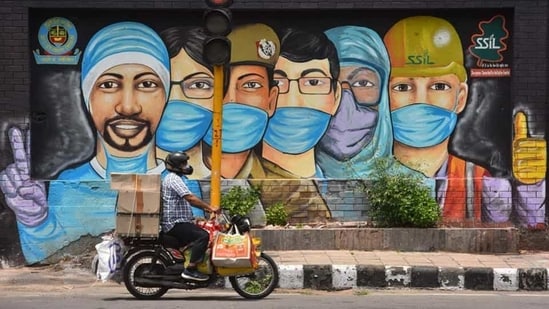Fiscal year 2020-21: A macroeconomic review
What was 2020-21 like for the Indian economy beyond the quarterly improvement from a 24% GDP contraction in the first quarter to a 0.4% growth in the third quarter of the year? Here are four charts that explain this.
Fiscal year 2020-21 ends today, March 31. With an estimated annual contraction of 8% in GDP, 2020-21 has been the worst year in terms of economic performance in India since 1950-51, the earliest period for which data is available.

While the Indian economy was losing growth momentum for several years before the pandemic, the exceptionally bad growth performance in 2020-21 is largely on account of the 68-day long hard lockdown which was imposed on March 25 2020 to prevent the spread of Covid-19 infections in the country, and continuing restrictions on economic and recreational activities for the rest of the year.
To be sure, the economy has been recovering with the easing of restrictions. India’s GDP re-entered growth territory in the quarter ending December 2020.
What was 2020-21 like for the Indian economy beyond the quarterly improvement from a 24% GDP contraction in the first quarter to a 0.4% growth in the third quarter of the year? Here are four charts that explain this.
1. The pandemic’s impact has been different on different sectors
The headline GDP number of 8% contraction does not capture the differential impact of the pandemic on different sectors of the economy, one reason why some experts say that the recovery isn’t a V-shaped one, but K-shaped.
Agriculture was the least affected by the pandemic and is expected to grow at 3%. The biggest reason? Lockdown restrictions never prevented any on-farm activity.
However, with a share of just over 16% in total Gross Value Added (GVA), agriculture could do little to cushion the overall performance of the economy. Both services and industry are expected to have suffered a contraction of slightly more than 8%.
To be sure, it is services which emerged the biggest drag on overall incomes, given its share of 54.6% in GVA.
Even within services and industry, employment-intensive sectors such as trade, hotel and restaurants and construction, have suffered a bigger contraction in economic activity. And 2021-22, unfortunately, isn’t beginning well, with at least some restrictions imminent on account of the ongoing second wave of infections.
2. Labour markets still bear the scars of pandemic
We do not have comprehensive official employment statistics for the fiscal year 2020-21. To be sure, the Periodic Labour Force Survey's (PLFS) findings for the quarter ending June 2020 – quarterly rounds only look at urban areas – were released earlier this month.
These numbers show that unemployment rates more than doubled to reach 20%-plus during the lockdown. However, PLFS numbers do not tell us about the subsequent recovery in urban areas or the state of employment in rural areas.
Private sources such the numbers collected by Centre for Monitoring Indian Economy (CMIE) and other high-frequency surveys such as Purchasing Managers’ Index (PMI) and Nomura India Business Resumption Index (NIBRI) have highlighted a continuing weakness in labour markets despite an improvement in production levels.
CMIE estimates also suggest that the pandemic has led to a further worsening of the gender gap in India’s labour markets.
The continuing weakness in labour markets, if it persists, is likely to generate demand side headwinds for growth going forward.
3. First food, now a non-food inflation problem in the making
Retail inflation as measured by the Consumer Price Index (CPI) stayed above 6%; the upper limit of the Reserve Bank of India’s tolerance band, continuously between April and November 2020.
While headline CPI growth fell sharply from 7.6% in October 2020 to just 4.1% in January 2021, it accelerated once again in February to 5%.
The crucial difference between inflation in 2020 and 2021 is the trajectory of food and non-food prices. The 2020 inflationary surge and subsequent moderation was largely driven by food prices, but over the past few months non-food inflation has been slowly gaining momentum in the economy.
Experts have attributed this to various factors including high taxes on petrol and diesel, companies trying to make up for lost incomes during the lockdown by raising prices, a spike in global commodity prices and an inflation in prices of various kinds of services.
The spike in non-food prices is likely to put pressure on purchasing powers and also prevent RBI’s monetary policy committee from slashing interest rates any further (they have been on hold since May 2020).
Meanwhile, prices of some crucial food items such as edible oils and pulses continue to grow at a high rate.
4. Will the pandemic impair India’s tax-GDP ratio?
Among the biggest uncertainties regarding the pandemic’s impact on the Indian economy is its impact on taxes. Even provisional estimates for the central government’s tax collections in 2020-21 will only be available in May.
The government slashed its Budget Estimates (BE) of 2020-21 Gross Tax Revenue collection by more than 21% in the Revised Estimates (RE) which were published in the 2021-22 Budget.
Even the 2021-22 BE number for Gross Tax Revenue is less than the 2020-21 BE target.
This is despite the fact that the government has had a windfall gain in taxes via increased excise duties on petrol and diesel. The 2020-21 RE and 2021-22 BE amounts under Union excise duties is 35% and 25% more than the 2020-21 BE number.
These statistics raise a serious question about the pandemic’s impact on India’s tax generation ability.
While this cannot be answered with certainty at the moment, any dent in the government’s tax generation ability is likely to increase tensions in an already stretched fiscal federalism framework and also limit the state’s ability to provide relief to those worst affected by the pandemic.
Stay informed on Business News, TCS Q4 Results Live along with Gold Rates Today, India News and other related updates on Hindustan Times Website and APPs








